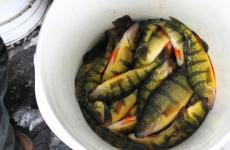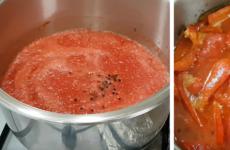Sewer pipe 110 red. Sewer pipe red price. What material is used to make a red pipe?
| Manufacturer | Guarantee | 10 years | Purpose | external sewerage | Subtype | Pipe | Diameter (inch) | d110 | A country | Russia |
* - Product images used on the site may include optional equipment and components not included in the standard product package.
** - Technical description The product is provided by the official representative of the manufacturer and is current as of the date the product appeared in our catalog. Manufacturer may slightly change the characteristics of the goods without our notice. Please check in advance specifications from managers.
*** - The price of the product is valid for consumers of the category " individuals". For legal entities There is a completely different loyalty program: prices for goods can differ both up and down and depend on factors such as the frequency of purchases, the number of goods ordered and many other features and circumstances. Read more about working with legal entities.
Nashorn plastic pipes for external sewerage designed for transporting sanitary Wastewater various chemical composition from buildings and structures in wastewater treatment plants. Painted in Orange color. Today, plastic pipes for external sewerage are replacing traditional metal pipes, as they are the most economical and profitable to operate.
Application
Nashorn PVC pipes for external sewerage systems are currently very successfully and widely used in the construction of buildings and structures when installing water supply and wastewater systems, in particular in sewer lines, for laying in the ground.
Peculiarities
The main features of Nashorn plastic pipes for external sewerage are high reliability and resistance to aggressive chemical compounds. It should also be noted that the product has a high service life, which significantly affects efficiency.
Advantages
The excellent anti-corrosion properties of polyvinyl chloride pipes allow you to install them with full confidence that the pipes will last as long as possible without clogging and additional cleaning costs. The smooth and scratch-resistant surface of the inner walls significantly increases the flow rate of liquids and promotes long service. Generally plastic pipes made of PVC have the following advantages:
Pickup. Pickup is free. Pickup point address: Moscow region, Tomilino town, Novoryazanskoe highway 25 km, st. 16, Pavilions 24G, 53B, territory of the Stroymarket on Ryazanka market. Working hours: Mon-Sun, 9:00-19:00.
Delivery of plumbing fixtures in Moscow and the Moscow region usually carried out the next day after receiving the application from 10:00 to 21:00 (without courier time restrictions). An hour or two before delivery, the courier contacts the buyer by phone. The courier forwarder may not contact the buyer who wished to receive SMS messages about the status of the order. In this case, an SMS message will be sent to the buyer’s cell phone stating that the order has been transferred for delivery, where the contact telephone number of the courier-forwarder will be indicated.
If the cost of the goods is more than 25,000 rubles. (without taking into account the discount: that is, taking into account the discount, the cost of the product may cost less than 25,000 rubles), then we will deliver this product to you free of charge within Moscow (within the Moscow Ring Road) and the territory adjacent to our warehouse (see map). in the event that the total cost of goods with free delivery is not less than 70% of the order amount or when the order amount is more than 35,000 rubles. (including the discount: that is, the order amount, taking into account the discount, must exceed 35,000 rubles).
Ascent to the floor. Based on the specifics of the product, as well as the fact that delivery is carried out by our delivery service, in most cases, by car (parking problems in Moscow), all delivery is carried out to the entrance. Lifting to a floor (with/without an elevator) is a paid service; its possibility, as well as the cost, are negotiated separately and in advance with the manager accepting the order. If the goods are oversized (up to 5 kg), then, at the buyer’s request, the courier forwarder can deliver the goods to the door, but is not obliged to do this: forwarders are kind people and will almost always help lift the goods for elderly people and pensioners.
In external sewerage and water supply systems, plastic pipes are used everywhere. Even when it comes to installing a sewer system, plastic is considered the best option, as it has many advantages.
Sewer red PVC pipes are designed to create a reliable, functional external sewerage and drainage network. Due to their optimal chemical and physical characteristics, these products can be used for the disposal of industrial and storm water.
For this reason, our online store “Drainage Shop” offers favorable conditions and low prices on plastic components of sewer networks. From us you can purchase products from leading manufacturers both wholesale and retail. A large assortment, any meter solutions and a sufficient selection of products made from different materials will make it possible to equip a highly efficient sewer system not only for a private home, but also for industrial purposes.
Red sewer pipe. Price
PVC pipes are manufactured using pressing technology under high pressure. The material most often used is polyvinyl chloride with polyethylene additives. PVC is a thermal polymer of vinyl chloride, which is widely used in various sectors of construction and everyday life. This material- excellent dielectric, immune to the effects of chemically aggressive compounds such as alkalis, acids, solvents, kerosene, mineral oils, gasoline and other things. The physical properties of plastic allow it not to corrode and retain its original factory qualities for a long time.
Where are red sewer pipes used?
- For the construction of swimming pools, water parks and fountains. The material is absolutely safe for humans.
- In the food industry. It is environmental friendliness and safety that make it possible to transport soda, lemonade, milk, and alcoholic drinks.
- In the spheres chemical production removal of gases and liquids that contain aggressive compounds.
- For the installation of sewers.
- In agriculture - drinking bowls for animals, watering.
Plastic sewer pipes are light in weight, which is very convenient for transportation or installation. The smooth inner surface promotes optimal fluid flow and prevents clogging. The temperature range of such products varies from -15 o C to +60 o C. Additional convenience lies in different diameters:
- 110 mm;
- 160 mm;
- 200 mm;
- 250 mm;
- 315 mm;
- 400 mm;
- 500 mm.
Thus, it is possible to equip a truly highly efficient external sewerage system or drainage system.
In addition, it should be noted that PVC products are among the first to be used in the pipe industry. Today, almost any manufacturer of plastic pipelines guarantees a service life of sewer components of up to 50 years.
The Drainage Shop company offers quite big choice high-quality plastic products for furnishing utility networks. We will help you choose suitable sizes and we will provide a discount.
Advantages of contacting us:
- Qualified personnel (assistance in selection suitable options, answers to all questions).
- Many years of successful experience in selling products in Moscow and the region.
- The assortment always has everything you need. The entire catalog of products offered is located.
- High-quality products with a manufacturer's warranty for more than 50 years.
If you need to install an external non-pressure sewer system for your home or industrial purposes, contact the Drainage Shop company.
Sewage system using plastic piping has become the norm modern life. There are many reasons for this phenomenon - both ease of installation and excellent performance characteristics products.
For the convenience of users, manufacturers paint products for external and internal sewerage in different colour. So, a gray pipe is used indoors, and a red one is used outside. External sewage systems experience increased mechanical stress and therefore require the use of especially strong and resistant materials.
What is the difference between the red sewer pipe and other varieties?
External installation of sewerage requires high resistance of products to temperature changes, and especially to the effects of negative temperatures. After all, being underground in frosty winter weather, which is so typical for our climate, can have a destructive effect on the material. The red pipe is characterized by increased frost resistance, as well as the following important characteristics:
- Increased rigidity;
- The walls are thick;
- Resistance to the aggressive environment of the transported liquid;
- Corrosion resistance;
- Chemical inertness;
- Long operating period.
What material is used to make a red pipe?
The red pipe is made from polymer material high quality, which surpasses all other types of plastic in key indicators, such as rigidity and linear expansion.

The red pipe for external sewerage can be smooth or corrugated, and the following material is allowed:
- Polyvinyl chloride (PVC);
- Polypropylene (PP);
- Polyethylene (PE).
Orange PVC sewer pipe – the best choice for an external wastewater transportation system, provided that the liquid temperature does not exceed 60 degrees.
Polyvinyl chloride products can be used for installing new sewer network, and for repairing an existing one. Due to the light weight of pipe products, they are easy to transport and install. You can cut the pipeline with an ordinary hacksaw, and for joining you do not need an expensive welding machine. All these qualities together have become the reason for the increased demand for red or red PVC pipes.
However, PVC, unfortunately, is not ideal material and, like all others, has some disadvantages. Among the negative characteristics are the following qualities that a brick or red sewer main has:
- Deformation of the product when the wastewater temperature rises to 70 degrees or more;
- Destruction under the influence of organic solvents;
- Insufficient elasticity of the pipeline;
- The characteristics of the material are somewhat reduced in severe frost.

Products made of polypropylene and polyethylene are more flexible and resistant to temperature changes. Polyethylene pipeline can be used either smooth or corrugated.
Features of polypropylene and polyethylene pipelines for external networks
If we are talking about polypropylene, then its main advantage is its resistance to exposure high temperature. This material has no restrictions on the temperature of the transferred liquid, and in addition is suitable for both pressure and non-pressure systems. The elasticity of polypropylene is several times higher than that of PVC.
However, the most flexible line today is polyethylene. It is not afraid of freezing, because in case of slight deformation it can easily restore its shape. The best option PE products for external laying is a two-layer red corrugated line, produced with round large diameter (from 110 mm).
Pipe diameter for external sewerage
Pipes for external sewerage collect all waste water that flows from plumbing fixtures located inside the building, and therefore must have large diameter. Selection of pipeline diameter for external sewerage must be carried out in accordance with SNiP 2.04.03-85. Most often, a diameter of 110 mm is sufficient, but if the house is large, then it may be necessary to use products with a diameter of 160 mm. To drain wastewater from several houses into a common septic tank, it is recommended to use pipes with a diameter of 315 mm; here the standard 110 will not be enough.

The standard pipeline diameter for external sewerage is 110 mm.
Features of laying an external sewerage system
External and internal sewerage- This one system, which is responsible for ensuring comfortable living in a house or country house. The external network starts from the point where the pipeline exits the building and ends with a septic tank, cesspool or any other device for collecting and cleaning fecal matter. To successfully install an external system, the following recommendations should be taken into account:
- It is necessary to outline in advance a plan for the location of system elements on the site, to indicate the location of the septic tank and drainage well.
- Purchase in advance necessary materials, and the diameter of the pipes should be selected at least 110 mm.
- The length of the red pipeline from a residential building to a septic tank must be at least 50 meters; this is the minimum distance from the house to the waste collection point.
- The 110 mm red pipeline should be laid below the soil freezing level, but above groundwater.

Installation of external sewerage
To equip the sewerage system, pipes of various diameters and from different materials. Modern level The development of technology allows, instead of heavy and expensive products made of steel and other metals and alloys, as well as ceramic and asbestos-cement pipes, to use lighter and easier-to-assemble materials - polymers. Thanks to the abundance of types of high-molecular compounds and their brands, you can choose a plastic product for any type of sewage system - internal or external; to ensure the functioning of the latter, redheads use PVC pipes.
Characteristics of sewer pipes
Sewage pipes must, primarily for sanitary or environmental reasons, guarantee the tightness of the pipeline. In addition, the selection of pipes depends on the type and volume of waste and the characteristics of the building from which the liquid is drained.
Sewer pipes must have the following properties:
- resistance to mechanical loads of static and dynamic types;
- the ability, when lying in the thickness of the earth, to bear the weight of the soil without bending;
- when installed under roads and highways - resistance to the weight of passing pedestrians and passing cars;
- mechanical strength of connecting nodes, capable of withstanding seasonal or sudden changes in groundwater levels.

It is clear that where the load on the pipes is greater (for example, under a busy highway), pipes with increased strength should be used. Mechanical strength- this is exactly what distinguishes a red sewer pipe from a gray one: the latter, as it is less resistant to loads, can be used when creating internal sewerage circuits, and orange PVC pipes are suitable for arranging external areas.
Characteristics of PVC pipes
These products are made from polyvinyl chloride, a polymer material characterized by the following properties:
- fire resistance;
- resistance to low temperatures;
- low temperature melting;
- light weight;
- increased, compared to polyethylene, rigidity and fragility under strong mechanical overloads;
- inability to conduct electricity, which makes it possible not to use additional electrical insulation;
- chemical resistance to most aggressive environments, including acids, alkalis, salt solutions, oil and gas products;
- no threat of corrosive decay under the influence of groundwater or other liquids.

PVC pipes remain functional when heated to a temperature of 120°C: above this value they lose their shape and begin to emit hydrogen chloride gas, which is harmful to human health.
The first signs of deformation begin below the specified temperature level, when heated to 65-70°C. That is why polyvinyl chloride products are not used to create hot water pipelines.
Advantages of polyvinyl chloride pipes
Red pipes for external sewerage have the following advantages:
- Light weight, which allows, without excessive physical effort and the use of expensive equipment, to carry out both installation and connection, as well as subsequent repairs and dismantling of the system.
- Resistance to mechanical overloads, including impact types.
- Small coefficient of linear expansion when changing temperature environment, due to which pipes with drained liquid maintain integrity even when freezing.
- Smoothness of the walls, ensuring the absence or extremely small amount of contaminants adhering during the operation of the sewer system. As a result, there is no need for additional work to clean the circuit, which reduces operating costs.
- Easy to install. To connect polyvinyl chloride pipes you do not need a welding machine, but cut sections required length You can use a regular hacksaw for metal, although the presence of specialized equipment simplifies the matter.
Classification of sewer polyvinyl chloride pipes
Red sewer pipes can be classified according to several criteria: the method of manufacturing the product, the use of finished products and ring rigidity.
According to the manufacturing method, such pipes are:
- single-layer - as the name suggests, they consist only of a PVC layer;
- multilayer - usually contain two layers of PVC and a reinforcing layer; All layers are connected with glue.

According to the method of application, products are divided into:
- pressure - used in sewerage under pressure, that is, forced movement of the working medium (read also: " ");
- non-pressure - used in gravity sewerage.
- Thin-walled lightweight class L (2 kN/m2).
- Thin-walled, medium-hardness class N (4 kN/m2).
- Thick-walled rigid class S (8 kN/m2).
Light pipes during installation sewer systems laid to a depth of up to 2 m, medium-hard ones - up to 6 m, high-hardness products - up to 8 m.
The ring stiffness value itself is the maximum permissible load per unit area, causing a deviation of the vertical diameter of no more than 4% without taking into account lateral resistance.

Pipelines made from PVC pipes are classified into three groups, considering the load volume, the location of the circuit and operating conditions:
- Light type pipelines. They are installed under sidewalks and park areas.
- Medium type pipelines. Mounted under sections of roads with not too busy traffic.
- Heavy-duty pipelines. Placed under buildings and roads with heavy vehicle traffic.
According to the shape of the surface, red pipes are:
- corrugated - multilayer, with smooth inner surface and outer dense shell; are particularly elastic;
- smooth - simple single-layer products.
Features of pressure and non-pressure pipes
Non-pressure products are designed to operate in areas of the system with normal load. Most sewers are characterized by precisely these conditions. Therefore, it is possible to assemble the circuit mainly from such cheaper pipes.
In those sections of the system where waste liquids are distilled using a pump, that is, under increased pressure, it is necessary to use pressure-type products that can withstand heavy loads. The same applies to areas with special difficult conditions functioning.

The use of a pump in autonomous sewer circuits is necessary because it helps clean the system. The pressure created by it is not constant and is characterized by an alternating increase and decrease, which creates a special load on the pipeline. Therefore, more expensive but safe pressure pipes must be installed in sewerage areas located in the pump’s operating area.
Dimensions of PVC sewer pipes
Sizes of red sewer pipes available on the market:
- length - from 1 to 6 m;
- diameter of products - in the range of 110...500 mm;
- wall thickness - 3.2...14.6 mm.
When arranging sewerage systems, red PVC pipes with diameters of 110, 160 (when running between buildings) and more than 200 mm (when laying along streets) are most often used.

Red sewer pipes with a cross section of 110 mm are used in the following cases:
- it is necessary to remove water drainage from residential buildings;
- during the arrangement internal contour sewerage systems in private low-rise houses and cottages;
- a surface drainage system is designed that continues linear or point drains.

Construction of an external sewerage system
The beginning of the external sewage system is the exit of the pipeline from the house or any other building, and the end is a reservoir for collecting wastewater and its subsequent treatment, for example, a septic tank.

Algorithm for constructing external sewerage:
- Design of an external sewer circuit, including the location of pipes and septic tank.
- Calculation of the required number of red pipes with a diameter of 110 mm (or more) and their acquisition and transportation to the place where the circuit will be installed (read also: " "). When calculating the length, it should be taken into account that cesspool should be located at a distance of 50 m from the building or more.
- Trench work. The width of the trench should be slightly larger than the width of the pipe.
- Creation of a sand and gravel cushion at the bottom of the channel.
- If necessary, add a geotextile layer to the cushion.
- Creation of inspection wells in places where the sewerage direction changes, serious changes in height, and in flat areas - every 6-12 m.
- Connection and laying of red polyvinyl chloride pipes. The fewer turns and bends there are during the creation of the contour, the better: this ensures tightness and reduces the risk of deposit accumulation. During assembly, all necessary fittings are used from the same material as the pipes.
- Burying laid pipes.
If these elements are not available, you should use plumbing sealant, applied to the end of the element inserted into the socket. If necessary, you can additionally process the end with sandpaper.

The end with the applied sealant should be inserted into the socket until it stops, then moved back 100-150 mm. The free distance will serve as a compensator for thermal expansion.
At the end of the procedure, the end of the pipe should fit into the socket at least 40-45 mm.
After carrying out a hydraulic test for 10-15 minutes, you can, if necessary, insulate the sewer circuit.
It is necessary to carefully carry out all stages of assembly, ensure uniform application of the sealant and do not neglect hydraulic testing: this will ensure tightness and long service life of the pipeline.
PVC pipe is made on the basis latest technology, suggesting the presence of an internal foam layer. During the manufacturing process, current standards are observed and the quality of products is strictly controlled. The red sewer pipe is made of several layers, it is tougher and stronger than the gray one, and can withstand strong soil pressures. The porous structure of the core layer of the material ensures low thermal conductivity of its surface.
PVC pipe is manufactured using the latest technology, which involves the presence of an internal foam layer. During the manufacturing process, current standards are observed and the quality of products is strictly controlled. The red sewer pipe is made of several layers, it is tougher and stronger than the gray one, and can withstand strong soil pressures. The porous structure of the core layer of the material ensures low thermal conductivity of its surface.
The external network has a hardness class of SN4, which allows you to bury them up to 1 meter.
The connection during installation is carried out using a socket method, and the tightness is ensured by a rubber O-ring. The pipe is laid in the ground with a slight slope along the drainage path.
Designed for drainage of wastewater from buildings and land plots.
External PVC sewer pipes, regardless of class, are not laid under highways for water drainage: they create a deflection when the slope changes, despite the ability to withstand high pressure and strength.
Advantages of external PVC pipe:
Durability. PVC pipes have a very long term operation, as they are resistant to rotting, corrosion, temperature and mechanical influences.
Tightness. Competently assembled system maintains tightness throughout its entire service life.
Environmental friendliness. The use of PVC pipes is completely safe for humans and the environment.
Ease and simplicity of installation. PVC external sewer pipes are lightweight, so they are easy to transport and install.
PVC sewer pipes are beneficial from an economic point of view because they are wear-resistant and low in price.






